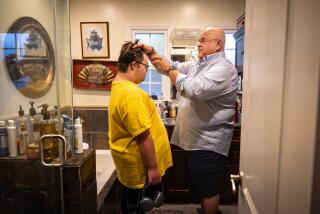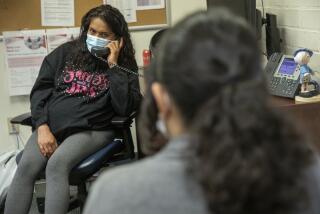Ailing Clinic Turns Children Away, Hunts for Funds
LONG BEACH — There are examining rooms at the Children’s Clinic of Long Beach that until three years ago were used as storage closets.
Painted a bright white, the cramped cubicles have clown posters and metal tables, but no sinks. Plumbing for sinks would cost $12,000, according to Barbara Haller, clinic administrator. “You can buy a lot of supplies for that,” she said.
For 47 years the clinic has provided free or nearly free medical care to the children of indigent and low-income families in Long Beach and surrounding communities. In the past five years, according to Haller, the number of patient visits has increased from 20,000 a year to about 30,000, requiring the conversion of three closets to augment the clinic’s 10 examining rooms.
Yet during the same period, she said, while expenditures increased about 33%, overall income to the independent, nonprofit facility in the basement of Memorial Medical Center has remained about the same. One result is that for the first time in its history, the clinic is turning needy children away. Another is that, frustrated by a lack of municipal support, some clinic boosters are stepping out of traditional, nonpartisan roles to politic for a better deal.
“It’s the nature of the American process,” said Dr. Laurence Carnay, a pediatric neurologist and president of the clinic’s board of directors. “We’ve been too busy taking care of kids . . . to develop a voice.”
Begun in Living Room
Begun in 1939 as a philanthropic venture operating out of a local pediatrician’s living room, involving 10 patients a week and a handful of physicians, the clinic occupied two other sites before moving to its present location seven years ago. Today, the number of physicians volunteering their services has grown to 60, representing more than 20 pediatric specialties from cardiology to orthopedics.
But the hours they donate are only part of the story. In addition to paying the salaries of 28 support staff members, the clinic must purchase supplies, pay rent to Memorial Medical Center and bear the burden of sometimes expensive medical procedures for which the patients’ parents generally pay less than $5 apiece.
The total cost per year, according to Haller, is slightly more than $1 million. About 20% of that, she said, comes from United Way. Another 24% comes from Medi-Cal, for which nearly half of the clinic’s patients are eligible. And much of the rest, Haller said, comes from private donors and foundation grants.
Yet income has not grown to match the increasing demand for services and their resulting costs. About five years ago, Haller said, the number of patients visiting the clinic began skyrocketing, due largely to federal and state cuts in medical aid programs; the growing reluctance of private physicians to accept Medi-Cal patients; the nationwide recession, and the growing number of immigrants settling in the Long Beach area.
Today, Haller said, 47% of the clinic’s patients are Latino and about 12% Asian.
$286,000 Accrued Deficit
Because of the increased demand, she said, the clinic has an accrued deficit of more than $286,000, an amount that is increasing by about $10,000 each month. Several steps have been taken to reduce the deficit, she said. Two-and-a-half years ago the Foundation for Children’s Health Care was formed, which among other things has organized two major fund-raising events for the clinic and recently began publishing a newsletter. Six months ago, Haller--who has a background in professional fund raising--was hired to help broaden the clinic’s base of support.
In January, the clinic stopped accepting new patients who are not chronically ill. As a result, Haller said, more than 200 children who would have previously been treated at the clinic have been referred to the nearby El Cerrito Health Services Center on Chestnut Avenue.
Edward Lee, administrator of the county-run center, said he has noticed a slight increase in the number of patients since February but could not attribute it specifically to referrals from the clinic. He said his pediatrics department handles about 200 patients a month--about the number the Children’s Clinic sees on a busy day. If necessary, he said, the center could handle an additional 80 children a month. But unlike the Children’s Clinic with its battery of specialists, Lee said, the county health center offers only general pediatrics, referring special cases to doctors at Harbor-UCLA Medical Center in Torrance, 10 miles away.
“My fear is that a lot of the children may not be getting any help,” Carnay said. Because some may have infectious diseases and most attend public schools, he said, the resulting public health problems could be considerable. “We traditionally have seen about 90% of the (sick) indigent children in the area,” he said.
That is one reason, Carnay believes, that the clinic has received two $5,000 grants from Paramount and one from Bellflower. He also said Norwalk and Signal Hill are considering grants for the coming year. One of his biggest frustrations, the neurologist said, is that, despite repeated requests, the City of Long Beach has not given the clinic any money in more than 10 years even though 52% of the clinic’s patients come from Long Beach.
‘No Room at the Inn’
“The response from City Hall has been zero. . . . I’m being told there’s no room at the inn,” Carnay said.
Mayor Ernie Kell said his advice to the Children’s Clinic would be to apply for a grant through the city’s Board of Health and Human Services rather than appealing directly to him, as it has in the past. “There are a lot of valuable services, but we can’t fund them all,” Kell said.
And Councilwoman Eunice Sato, whose district includes the clinic, said that, while she personally supports its work, she cannot justify giving the facility preferential treatment over other nonprofit agencies. “They have to understand that if we give to one agency, we have to give to others,” Sato said. “I’ve been supportive personally and . . . gone to their functions, but I can’t deliver money to them. We don’t have that kind of money.”
Carnay says it is precisely these kinds of sentiments that have prompted him to take an active interest in local politics lately. Though he lives in Rancho Palos Verdes and has a medical practice based in Paramount, Carnay said he recently joined Long Beach Area Citizens Involved, a group of Long Beach activists opposed to Sato’s reelection in next month’s municipal primary elections.
In fact, Carnay said, he has even contributed $600 to the campaign of one of Sato’s opponents--Ray Grabinski--and plans to contribute more before the April 8 primary.
In a telephone interview on Wednesday, Grabinski would not promise to support city funding for the Children’s Clinic. But he did say that, as a councilman, he would try to exhibit more sensitivity to the needs of “those kinds of organizations” than has been shown by the present council.
‘Lack of Attention’
“I have four children and I am concerned about all the children who live in the city,” Grabinski said. “I think there has been a real lack of attention to the children. Any group that has been doing as much good as the clinic I think would deserve support.”
Without city support, Carnay and other supporters fear the clinic may ultimately be forced to close. Meanwhile, they see some cause for optimism in the recent appointment of Rae Gabelich, a member of the clinic foundation’s board of directors, to the city’s Board of Health and Human Services.
A 15-member citizen’s advisory panel, the health board will determine annual disposition of $700,000 in anticipated yearly interest revenues on a $6.65-million municipal endowment from the sale of city land a few years ago to two local hospitals. Gabelich, also a new member of Citizens Involved, said she intends to lobby for a portion of the money on behalf of the Children’s Clinic.
City officials expect to distribute the first grants in June. However, it is questionable whether the clinic can get any money in this first round. According to Nancy Johnson, manager of the special services bureau of the Department of Parks and Recreation that is overseeing the allocation process, the first year’s allocations will be made in eight specific priority areas outlined in a 1985 “Human Service Needs and Resources” study commissioned by the city. Among them: psychological counseling, child day care, recreation and English-language tutoring. Nowhere does the study, conducted by The Urban Institute of Washington, mention pediatric medical care as a priority in Long Beach.
Clinic ‘Never Came Up’
“The need of the Children’s Clinic never came up,” said Dr. Ugmini Shah, the city’s director of public health.
Next year, she said, priorities will be determined by the advisory panel.
The clinic’s importance to its patients, however, was obvious during a recent visit to the facility, where dozens of children squirmed in their parents’ laps or raced across carpeted floors while waiting to see doctors.
“I can’t afford a private doctor,” said Sandra Smith, a Torrance mother of three whose husband’s job with an independent moving company does not provide medical insurance but brings in too much money for the family to qualify for Medi-Cal.
On this particular day, Smith said, she had brought all three of her children--ages 1 1/2 to 5--to the clinic for checkups, considered particularly important for her 3-year-old daughter who is recovering from a urinary tract infection. During a recent visit to Harbor-UCLA, she said, she paid $30 per child, while here she was paying only $8. “You can only pay so much,” Smith said.
Vaji Goudarzi of Bellflower said she regularly brings her three children to the clinic because she and her husband are both students and cannot afford to go anywhere else. “If I couldn’t come here I’d have to rely on books and the (advice of) neighbors,” she said. “If something happened, I would have to solve it at home and take a big risk.”
Carnay remains philosophical about what he considers the life-and-death struggle of the clinic he loves.
“A clinic for children should not be allowed to close,” he said during a recent interview in his Paramount office. “If we could get more people to realize that every child is, in part, their child, we would have a better city. We don’t have to go to Ethiopia (to help children), we can do it right here in Long Beach.”
More to Read
Sign up for Essential California
The most important California stories and recommendations in your inbox every morning.
You may occasionally receive promotional content from the Los Angeles Times.









